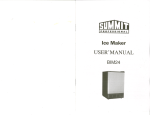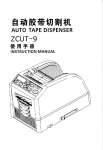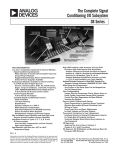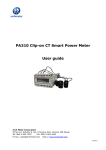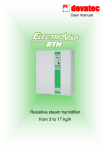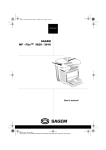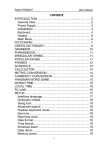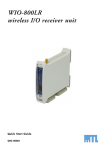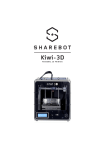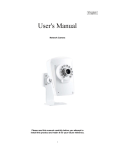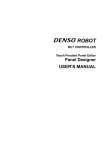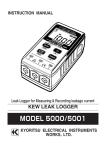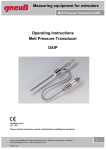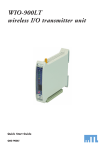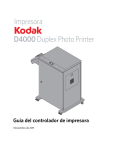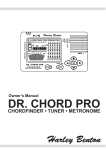Download HERE
Transcript
Manual Wheel Balancer
User Manual
INDEX
1—DESCRIPTION OF THE BALANCING MACHINE
1.1-GRNERAL
1.2-TECHNICAL DATA
1.3-USER RECOMMENDATION
2—HOISTING AND INSTALLATION
2.1--MACHINARY INSTALLMENT 2
2.2--ELECTRIC CONNECTION2
3—CONTROL PANEL
3.1--MEANING OF DISPLY PANEL3
3.2-- MEANING OF CONTROL PANEL3
3.3—FUNCTIONCONVERSION KEYS3
4—WHELL MOUNTING
4.1--SCREW SPINDLE SCREW ROD INSTALLMENT 4
4.2--TIRE INSTALLMENT4
5--PRESETTING OF DIMENSIONS4
6--SELF-CALIBRATION5
7--WHELL BALANCING6
7.1--MEASUREMENT OF UNBALANCE6
7.2--TO MINMIZE STATIC UNBALANCE6
7.3--STATIC-ALU6
7.4--SPECIAL “S” FUNCTION7
8—ERRORS
9—ROUTINE MAINTENANCE
9.1--TO REPLACE THE FUSES9
9.2--UNSTABLE BALANCE DISPLAY9
10--TO CHECK THE DISTANCE GAUGE9
10.1--THE DISTANCE GAUGE DOES NOT REQUIRE ANY ADJUSTMENT.9
10.2-- CHECK THE POSITION SENSOR9
10.3--ASSEMBLY OF THE PIEZO MEASURERS
10.4--TECHNICAL DATA SETTING UP
2
2
2
2
2
3
4
8
9
10
11
1
1--DESCRIPTION OF THE BALANCING MACHINE
1.1--GRNERAL
It is an electronic balancing machine with microprocessor designed for balancing wheels weighting up to 65kg.
The push button controlled calibration system allows a range of adjustment which is also sufficient to cover
wheels
Differing from ordinary ones (motorcycles and racing cars).
Special functions are also available to cater for wheels of unusual shape and there is provision for optional
functions of the balancing machine.
1.2--TECHNICALDATA
Max wheel weight
voltage
Balancing accuracy
Rim diameter
Rim width
Cycle time
Net weight
Overall dimension ofmachine
Operating temperature range
65kg
220v / 50HZ
±1g
from 10″to 24″or from 254 to 609.6mm
from 1.5″to 20″or from 38.1 to 508mm
15s
83kg
900x540x995(mm)
from 0 ot 50℃
1.3--RECOMMENDATIONS
-Before starting to use the balancing machine, carefully read the operating instruction manual.
-Keep the manual in a safe place for future reference.
-Refrain from removing or modifying machine parts which would impair correct operation. Please get in
touch with the technical service when needing repairs.
-Do not use strong jets of compressed air for cleaning.
-Use alcohol to clean plastic panels or shelves (AVOID LIOUIDS CONTAINING SOLVENTS)
-Before starting the wheel balancing cycle, mark sure that the wheel is securely locked on the adapter.
-The machine operator should not wear clothes with flapping edges; make user that unauthorized
personnel do not approach the machine during the work cycle.
-Avoid placing counterweights or other bodies in the base which could impair the correct operation of the
balancing machine.
-the balancing machine should not be used for purposes other than those described in the instruction
manual.
2--HOISTING AND INSTALLATION
2.1--MACHINARY INSTALLMENT
2.1.1Check parts are in good condition or not. Please contact supplier if any question.
2.1.2 Installed on the flat and solid ground, otherwise wrong measurement.
2.1.3 500mm around the machine is free for convenient operation.
2.1.4 Fasten the machine through the base eyelet .
2.2--ELECTRIC CONNECTION
(OPERATED BY SPECIAL PERSONNEL)
2.2.1 Select related power supply according to technical data and add to automatic air switch.
2
2.2.2 Select the plug with ground wire. The wire of yellow and green is ground wire, connecting with floor .
The wrong connection will damage the computer.
3--CONTROL PANEL
FIG.1
3.1--MEANING OF DISPLY PANEL
1. Digital display, AMOUNT OF UNBALANCE inside
2. Digital display, AMOUNT OF UNBALANCE, outside
3. Indicator, POSITION OF UNBALANCE, inside
4. Indicator, POSITION OF UNBALANCE, outside
5. Indicators, balance mode
3.2-- MEANING OF CONTROL PANEL
6. Push button for reading unbalance<5g (0.3oz)
7. Push button, balance mode selection
8. Push button for re-calculate:/self-calibration
9. Push buttons a, manual rim DISTANCE input
10. Push buttons b, manual rim WIDTH input
11. Push buttons d, manual rim DIAMETER input
12. Push button, rapid swiching between DYNAMIC /STATIC(selection of optional functions)
13.Conversion key of big wheel
14. Conversion key of small wheel
NB: Only use the fingers press the push buttons, NEVER use the pincer for the counter weights or other pointed
objects.
3.3--FUNCTION CONVERSION KEYS
3.3.1 PRESETTINGS MEMORIZED ALSO WHEN MACHINE IS SWITCHED OFF:
F
+
+a
+
-a
-UNIT of measurement of unbalancegrams/ounces
3
3.3.2 PRESETTINGS LOSTED WHEN MACHINE IS SWITCHED OFF:
F
+
+b
-UNIT of measurement of width mm/inch
or
F+
-b
(from “PRESETTING OF DIMENSIONS” by selecting WIDTH).
N.B:-In inches each time machine is switched on.
F+
+d
-UNIT of measurement of DIAMETER mm/inch
or
F+
(form “PRESETTING OF DIMENSIONS” by selecting DIAMETER)
-d
N.B:-In inches each time machine is switched on.
3.3.3 DISPLAY OF UNBALANCE:
F
Dynamic
ALU
Static
Dynamic
S >1 >2
>3
>S
4--WHEEL MOUNTING
4.1--SPINDLE SCREW ROD INSTALLMENT
Clean the anti-rust with industrial alcohol or gasoline before screw rod mounting to protect installment precision.
Screw rodin accessories, aim at the mounting holes, make screw rod and spindle fixed.
4.2--TIRE INSTALLMENT
4.2.1 Mounting the cone which is suitable for rim aperture on the spindle. If the rim is less than “15”,the
butterfly spring towards outside, then mounting cone and the tire; If the rim is more than “16”, doesn’t mounting
butterfly spring, the smaller side of the cone towards inside, mounting tire and then the cone.
4.2.2 Fasten with quick nut after above all.
5--PRESETTING OF DIMENSIONS
FIG.2
4
Rim data is stored in the machine. Input data and press [↑ ]or [↓] to get
the right data.
Press distance “a” on the inside of the wheel from the machine measuring it
with the special gauge.(Increment pitch 0.5cm. Full scale 26cm)
FIG.3: DISTANCE
Preset the nominal width which is generally given on the rim, or else measure
width “b” with the caliper gauge (supplied as standard).
(increment pitches:-unit of measurement mm:5mm
-unit of measurement inch:0.25"the following is displayed: 0.2 for 1/4",
0.5 for 1/2",0.7 for 3/4")
FIG.4: WIDTH
Preset the nominal diameter “d” stamped on the type:
(increment pitches:
-unit of measurement mm:12/13mm
-unit of measurement inch:0.5")
FIG.5: DIAMETER
6--SELF-CALIBRATION
For machine self-calibration, proceed as follows:
-Mount any wheel on the shaft, even if not balanced; better still if of an “average” size.
-Preset the exact dimensions of the wheel mounted.
CAUTION!! Presetting of incorrect dimensions could mean the machine is not correctly calibrated and
therefore all subsequent measurements will be incorrect until a new self-calibration is performed with the
correct dimensions!
Display [CAL] [CAL]
Until the full brightness of the unbalanced position indicator stops flashing,
release the button. Manual rapid clockwise rotation the
spindle,after the indicator is off, stop shaking, until the
indicator displayed: [ADD] [100], step down the brake pedal,
the spindle stops rotating, outside add 100g(3.5oz)Balanced
block, rapid clockwise rotation the spindle again,
FIG.6after the indicator is off, stop shaking, as the indicator is off
However, self-calibration can be carried out whenever
required or when there is some doubt whether the machine is
operating correctly. (fig.6)
5
7--WHELL BALANCING
7.1-- MEASUREMENT OF UNBALANCE
-To make a measuring spin, close the guard (alternatively press).
-In a few seconds the wheel is brought up to speed and a new braking;the amounts of unbalance remain
memorized on instruments 1 and 2.
-The illuminated LEDdisplays show the correct angular position where to fit the counterweights (12o’clock
position).Start the breaker and keep it still.
-In this screen, a light pressing of key
will display in sequence the preset dimensions.
C
FIG.7: POSITIONING AND CORRECTION ON THE OUTSIDE
FIG.8:POSITIONINGAND CORRECTION ON THE INSIDE
7.2-- TO MINMIZE STATIC UNBALANCE
-When standard commercially available weights with pitch of 5g every 5g, an unbalance of up to 4g can remain.
The damage of such approximation is conspicuous for the fact that most of the distrubances of the vehicle are
caused by approximating them in “intelligent” mode according to their position
- Press
to display actual unbalance (0-4g)
FINE
- The instruments show “0” for unbalance less than 5 grams/0.4 oz to display the residual unbalance, press
FINE
7.3--STATIC-ALU
The available functions show where to place the corrective weights in positions differing from the normal ones.
-Press
ALU
orto Fselect the required function
6
-The amounts of unbalance are displayed correct on the basis of the selected
correction position.
Normal-Balancing of steel or light alloy rims by applying clip-on
weights on the rim edges.
Static- STATIC correction is required for motorcycle wheel or when it is
not possible to place the counterweights on both sides of the rim.
(ALU)1- Balancing of light alloy rims with application of adhesive wights
on the rim shoulders.
(ALU)2- Balancing of alloy rims with hidden application of the outer
adhesive weight. Position of the outer weight is the one shown in the figure.
(ALU)3Combined balancing: clip-on weight on inside; hidden
application of the adhesive weight on the outside (Mercedes).
(Position of the outer weight as in ALU2).
FIG.9
7.4--SPECIAL “S” FUNCTION
The function is used for unusually shaped alloy rims where “ALU2” is not able to guarantee sufficient accuracy.
-Select the S option (relative LED light up) through the [ALU] push button.
-Take note of the dimensions following the diagram given below:
FIG.10
Sequence:
a) To modify al press
“al” The distance between machine body and inside counterweights
“aE” The distance between machine body and outside counterweights
7
“dl” The diameter dimension of inside counterweights of rim
“dE” The diameter dimension of outside counterweights of rim
b) To modify aE press
c) To modify dl press
N.B: by default dE is=0.8dl
d) To change dE press
(keep ALU pressed)
N.B: When dl is reselected, the system automatically returns dE=0.8dl.
The system automatically calculates the distance between the cents of gravity of the weights considering them to
be about 14mm wide. To displace the unbalance associated with preset dimensions, press key [C]. if a spin has
already been made, the system automatically recalculates the unbalance; otherwise press the [STRAT] key for a
new spin.
8--ERRORS
Various abnormal conditions can arise during machine operation. If detected by the microprocessor, they appear
on the display, thus:
Err.
—S—
ERROR
1
2
3
4
5
6
MEANING
No rotation signal. Could be caused by faulty position transducer, or something
preventing.
During the measurement spins, wheel speed had dropped to below minimum 60
r.p.m repeat the spin.
Error in mathematical calculations; most probably caused by too high wheel
unbalance.
Manual rotation in opposite direction, position sensor wiring errors.
Fault in memory of the self-calibration values. Repeat the self-calibration.
Error during self-calibration. Could be due to the second spin made without adding
reference weight, or else by a break in the transducer cable.
8
9--ROUTINE MAINTENANCE (Non specialized personnel)
Warning! Before carrying out any operation, disconnect the machine from the mains.
9.1--TO REPLACE THE FUSES
Remove the weight holder shelf to gain access to the power supply PC board and the two fuses mounted on this
board. If the fuses require replacement, use ones of the same current rating.
If the failure persists, contact the Technical Service Department.
9.2--UNSTABLE BALANCE DISPLAY
If after balancing, when the wheel is refitted on the vehicle, it is still out-of-balance, this could be due to
unbalance of the car brake drum or every due to the holes for the screws of the rim and drum drilled sometimes
with too wide tolerances. In such case a readjustment could be advisable using the balancing machine with the
wheel mounted.
SPECIAL MAINTENANCE
(Only for specialized personnel )
10--TO CHECK THE DISTANCE GAUGE
10.1--THE DISTANCE GAUGE DOES NOT REQUIRE ANY ADJUSTMENT.
Just be careful when changing the graduated scale.Position it so as to read 0 at the fixed indexlimit(reading point)
when the tip coincideswith position shown in the figure.
FIG.11
10.2--CHECK THE POSITION SENSOR
To check efficiency of the position sensor, proceedas follow:
1.
Make sure that none of the three photocells rub
against the phase disk and RESET tooth.
2.
Using a voltmeter set to the Vd.c. scale, test the Following voltages (the machine should be switched
9
On but without rotation):
*between earth (ground) and red wire +5Vdc steady
*between earth (ground) and yellow wire (RESET)
+4.5 to 4.8Vdc when the RESET tooth is in
photocell TCST 2000 and “0”Vdc when the RESET
tooth is outside the photocell.
*between earth and the green wire (CLOCK) and
between earth and the white wire (U/D), when the
machine shaft is turned very slowly, there should be
a variation in voltage going from “0”Vdc to 4.5/4.8
Vdc.
CAUTION: when the position sensor requires
replacement, remove just the PC board after backing-off
the two mounting screws; as the mounting bracket is not
moved, repositioning is easier.
10.3--ASSEMBLY OF THE PIEZO MEASURERS
ASSEMBLY INSTRUCTIONS
Problems of excessive out-of-phase and compensation, sometimes depend on a fault in the piezomeasurers.
To replace them, proceed as follows:
1. Dismounting cover and holder shelf.
2. Dismounting nuts 1 and 2 with relative cup springs and washers.
3. Dismounting nuts 3,4, then disassemble the various parts.
4. Reassemble the various parts without tightening the nuts being careful to follow the correct sequence.
N.B: the piezo units should be mounted in according with the position of the coloured wires shown in
the drawing.
5. Keeping the spindle perfectly aligned, tighten nut 5 with a spanner and nuts 3 and 4 by hand (plus half
a furn with the spanner if necessary).
6. Refit the cup springs and nuts 1 and 2. Tighten these nuts fully in order to fully regain the elasticity of
the cup springs; then loosen them by half a furn. In this way the correct preloading of the piezo will be
obtained (a troque wrench can be used set at 400kg.cm).
7. Cover the piezo units with a generous layer of silicone,
10
(N.B. for correct operation, insulation of the piezo crystals should be greater than 50Mohm).
8. Refit the cover and weight holder shelf.
9. Repeat the self-calibration operation.
10.4-- TECHNICAL DATA SETTING UP
The correct technical data makes sure the wheel balance precision.
Press {F}+{C},and then press the keys according t the following steps within 5 seconds when the light begins to
shine. {-a}---{+a}----{F}.
When you press {-a} and {+a},the display screen will disappear.
Press{F},the present distance data will be on.
{DF}{125}, the right data is {DF},Press {+b}and {b}to change the data {DF}.
Press {+a}to shift data” I”
When{I}and {-3}are displayed, Data ”I” is displayed on the right side. Press {+a} to shift data “S”
When {S} and {330} are displayed, press {+b} and {-b} to change data “S”, and then press {+a}to conclude the
operation.
11












